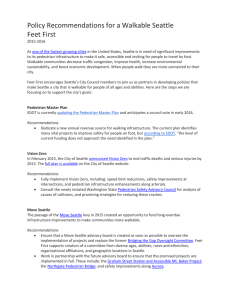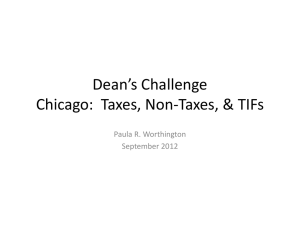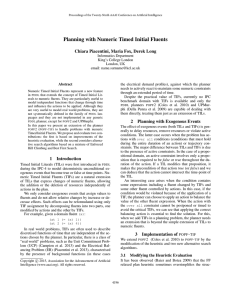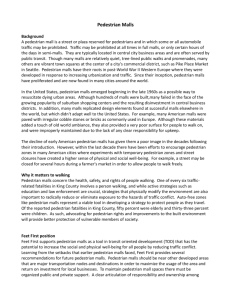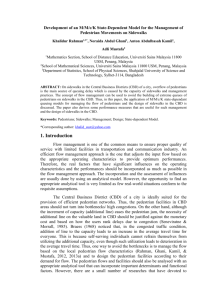Word - Feet First
advertisement
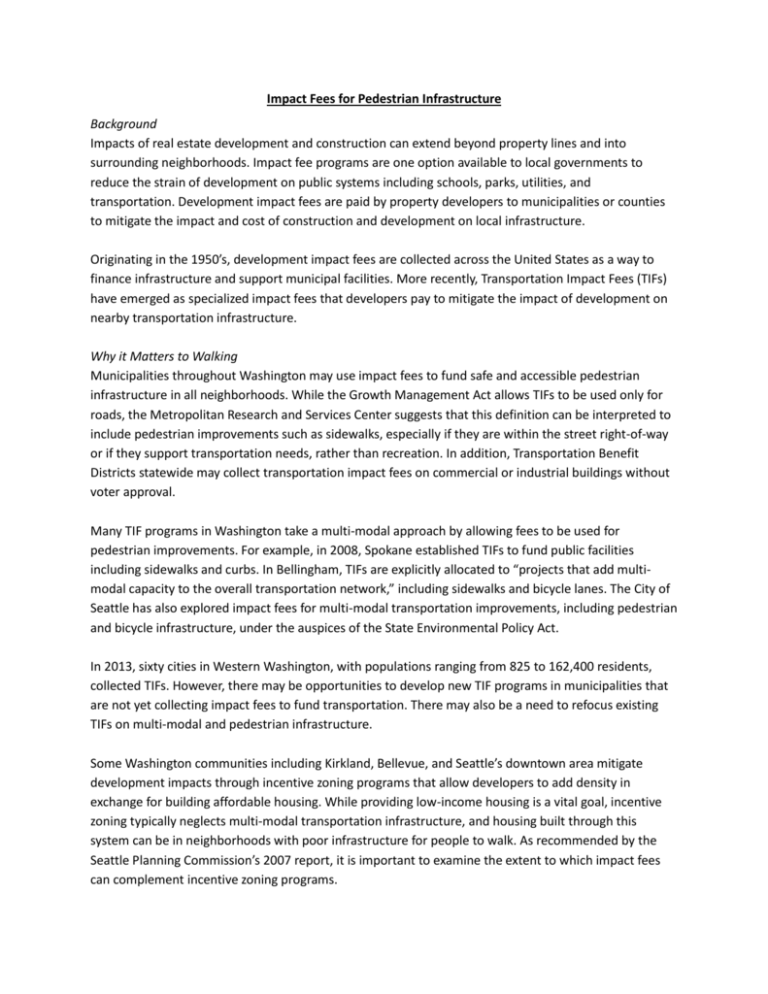
Impact Fees for Pedestrian Infrastructure Background Impacts of real estate development and construction can extend beyond property lines and into surrounding neighborhoods. Impact fee programs are one option available to local governments to reduce the strain of development on public systems including schools, parks, utilities, and transportation. Development impact fees are paid by property developers to municipalities or counties to mitigate the impact and cost of construction and development on local infrastructure. Originating in the 1950’s, development impact fees are collected across the United States as a way to finance infrastructure and support municipal facilities. More recently, Transportation Impact Fees (TIFs) have emerged as specialized impact fees that developers pay to mitigate the impact of development on nearby transportation infrastructure. Why it Matters to Walking Municipalities throughout Washington may use impact fees to fund safe and accessible pedestrian infrastructure in all neighborhoods. While the Growth Management Act allows TIFs to be used only for roads, the Metropolitan Research and Services Center suggests that this definition can be interpreted to include pedestrian improvements such as sidewalks, especially if they are within the street right-of-way or if they support transportation needs, rather than recreation. In addition, Transportation Benefit Districts statewide may collect transportation impact fees on commercial or industrial buildings without voter approval. Many TIF programs in Washington take a multi-modal approach by allowing fees to be used for pedestrian improvements. For example, in 2008, Spokane established TIFs to fund public facilities including sidewalks and curbs. In Bellingham, TIFs are explicitly allocated to “projects that add multimodal capacity to the overall transportation network,” including sidewalks and bicycle lanes. The City of Seattle has also explored impact fees for multi-modal transportation improvements, including pedestrian and bicycle infrastructure, under the auspices of the State Environmental Policy Act. In 2013, sixty cities in Western Washington, with populations ranging from 825 to 162,400 residents, collected TIFs. However, there may be opportunities to develop new TIF programs in municipalities that are not yet collecting impact fees to fund transportation. There may also be a need to refocus existing TIFs on multi-modal and pedestrian infrastructure. Some Washington communities including Kirkland, Bellevue, and Seattle’s downtown area mitigate development impacts through incentive zoning programs that allow developers to add density in exchange for building affordable housing. While providing low-income housing is a vital goal, incentive zoning typically neglects multi-modal transportation infrastructure, and housing built through this system can be in neighborhoods with poor infrastructure for people to walk. As recommended by the Seattle Planning Commission’s 2007 report, it is important to examine the extent to which impact fees can complement incentive zoning programs. Feet First Position Impact fees are a viable revenue source for projects that create more walkable neighborhoods, support equitable transportation, and give people a choice of safe, accessible opportunities to go by foot. Feet First supports impact fees as an important component of financing pedestrian infrastructure, and advocates the expansion of multi-modal transportation impact fees to support the development of walkable communities throughout Washington. Resources City of Bellingham: FAQs About Transportation Impact Fees: http://www.cob.org/documents/pw/transportation/2013-tif-faq.pdf City of Spokane Engineering Services: Transportation Impact Fees: http://www.spokaneengineering.org/transportation-impact-fees-2 Multi-Modal Impact Fees: http://www.westernite.org/Sections/washington/newsletters/Samdahl%20multimodal%20impact%20fe es.pdf Municipal Research and Services Center of Washington: A Comparison of 2013 TIF Base Rates: http://www.mrsc.org/govdocs/b45tif2013.pdf Municipal Research and Services Center of Washington: Featured Inquiry (09/28/09): http://www.mrsc.org/askmrsc/featuredinq.aspx?inq=614 Seattle Planning Commission: Incentive Zoning in Seattle http://www.seattle.gov/Documents/Departments/SeattlePlanningCommission/IncentiveZoning/SPC_Inc entive%20Zoning.pdf Seattle Transportation Benefit District: http://www.seattle.gov/stbd/faq.htm


